As the Vice President of Sales and Director of Marketing for Leighton Media, I’ve been at the forefront of our company’s celebration of 60 years.
As my team and I prepared for this event, we visited the Stearns County Historical Society and looked through clippings and images from decades of broadcasting in Central Minnesota. Tales of radio promotions with hundreds of people in line for one dollar and four cent gas, raft races down the Mississippi, and bumper stickers galore! Newspaper clippings of “radio wars” and stations flipping formats. The competition for the share of the ear was strong then and remains today.
Today, our options for audio consumption go far beyond the dial, and audio consumption is at an all-time high. While much has changed, some things remain the same — radio advertising is holding its ground in an era dominated by digital marketing.
Timeline Of Radio Through The Years
Over the past 60 years, radio has changed significantly to adapt to technological advancements, cultural shifts, and changing consumer preferences. Here are five of the most important transitions this traditional advertising medium has faced during our company’s existence:
The Emergence of FM Radio
FM stands for Frequency Modulation, and as radio gained popularity over the years, specifically in the decades of the 50s and 60s, it eventually surpassed AM (Amplitude Modulation) radio in many regions due to its better sound quality and resistance to interference.
Consolidation and Deregulation
In 1996, President Bill Clinton signed the Telecommunications Act into law, raising the national ownership cap and allowing for more cross-ownership between radio stations, TV stations, and newspapers in a single market. Large media conglomerates acquired multiple radio stations, sometimes resulting in less diverse content.
Satellite Radio
In the early 2000s, satellite radio services like Sirius Satellite Radio and XM Satellite Radio became popular in the United States. They offered commercial-free programming and a wide range of specialized channels, making them an attractive alternative to traditional terrestrial radio. Both companies would compete for several years but, by 2008, merged due to financial challenges.
The Transition From Analog To Digital
Another one of the most significant changes in radio technology was the shift from analog to digital broadcasting, better known as HD Radio, in the early 2000s. Digital radio offers higher auto quality, reduced interference, and the ability to transmit additional data, such as song information and album art.
Internet Radio
Another advancement that gained momentum during the 2000s with the rise of accessibility to the Internet was Internet radio, better known as online radio or web radio. Internet radio is a form of digital audio broadcasting that uses the Internet to transmit audio content to listeners. Unlike traditional terrestrial radio, which relies on broadcasting towers to transmit signals over the airwaves, Internet radio stations stream their content online, making it accessible to anyone with an Internet connection. The rise of the Internet led to the development of Internet radio platforms and streaming devices.
Local Radio Keeping You Connected To Local Business
These changes detailed above and many more demonstrate the resilience and adaptability of radio as a medium, continually evolving to meet the demands and preferences of its audience in the digital age. Here are some of the key ways in which local radio can influence and benefit local businesses:
Targeted Advertising
Local radio stations can cater to specific geographic regions, allowing businesses to target their advertising efforts to a local audience. This is especially valuable for small businesses primarily serving customers in their immediate vicinity.
COST-EFFECTIVENESS
Local radio advertising is much more affordable than national or regional advertising channels. This cost-effectiveness allows smaller businesses with limited marketing budgets to reach their target market effectively.
Community Connection
Local radio stations are embedded in the community and often have a loyal listener base. When businesses advertise on the local radio, they can tap into this sense of community connection and trust, improving brand loyalty and customer engagement.
Immediate Impact
Unlike other advertising channels, radio can have an immediate impact. People often listen while driving or performing daily tasks and can respond quickly to compelling ads and take immediate action, such as visiting the advertised business.
Supporting Local Causes
Many local radio stations actively participate in community events and support local causes. Businesses aligning with these initiates can enhance their brand image and reputation among local consumers.
Radio Endorsements
A popular radio host endorsing a local business or product can be highly influential. Listeners often trust the recommendation of a familiar radio personality, and such endorsements can boost credibility and brand recognition for the business.
Emergency Communication
During times of crisis or emergencies, local radio can play a crucial role in disseminating information to the community. Businesses can use this platform to communicate important updates or aid those affected.
Staying Live and On-Air
As you can see, local radio is still a valuable advertising and community engagement platform for local businesses. Leighton Media is proud to celebrate 60 years with the communities we serve, connect, and honor. Marketing solutions for local businesses is our passion, and we look forward to the future with the belief that the best is yet to come.
Pictures From Our 60th Anniversary Celebration
.jpg?width=889&height=465&name=1%20(2).jpg)
The Leighton Media 60th Anniversary Banner.

Handing out our celebratory team shirts.
.jpg?width=889&height=465&name=5%20(1).jpg)
A closer look at our anniversary shirts.
.jpg?width=889&height=465&name=3%20(1).jpg)
Our team gathering to unveil the new banner.

Our new production studio is in action.

Bob Leighton, our President and CEO, cutting the ribbon for our new building.
